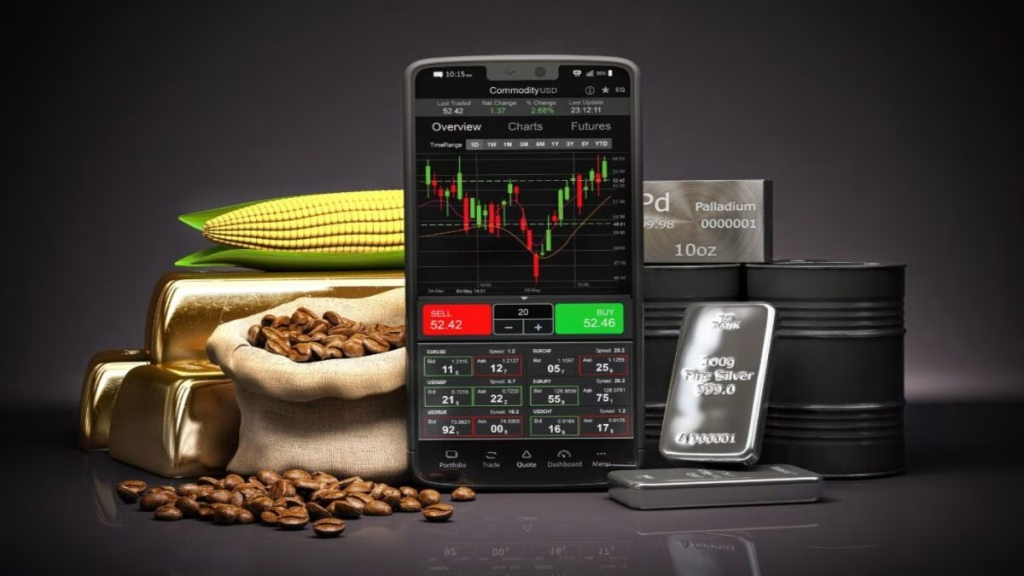Commodity trading is one of the oldest forms of market speculation, offering investors and traders the chance to profit from price movements in physical goods such as oil, gold, natural gas, agricultural products, and metals. Whether you’re a beginner or an experienced investor, mastering commodity trading requires a strong understanding of market fundamentals, technical skills, and risk management strategies.
In this comprehensive guide, we’ll explore the most effective commodity trading tips to help you make informed decisions and improve your performance in today’s dynamic market.
Commodity Trading Tips 2025
What Is Commodity Trading?
Commodity trading involves buying and selling raw materials and primary agricultural products. Commodities are typically divided into two main categories:
- Hard Commodities:
Natural resources like gold, silver, oil, copper, and natural gas.
- Soft Commodities:
Agricultural goods like wheat, corn, coffee, cotton, and sugar.
These commodities are traded on exchanges like the Chicago Mercantile Exchange (CME), London Metal Exchange (LME), and Multi Commodity Exchange (MCX). Most trading happens via futures contracts, where you agree to buy or sell a specific quantity at a future date and price.
Top Commodity Trading Tips for 2025
Whether you’re trading for profit or hedging risks, these essential commodity trading tips will help you develop a robust strategy and avoid common pitfalls.
1. Understand the Fundamentals
Each commodity has its own supply and demand dynamics. For instance:
- Oil prices are affected by OPEC decisions, geopolitical tension, and refinery output.
- Gold often moves in response to inflation, interest rates, and currency values.
- Agricultural prices depend on weather conditions, harvest cycles, and global demand.
Tip: Stay updated with economic reports, weather forecasts, and geopolitical developments. Websites like the U.S. Energy Information Administration (EIA), World Bank, and USDA offer regular data.
2. Use Technical Analysis Wisely
Charts and patterns are vital for short-term commodity trading. Common tools include:
- Moving averages:
Identify trends and reversals.
- RSI (Relative Strength Index):
Shows overbought or oversold conditions.
- Support and resistance levels:
Help predict price ranges and breakout points.
Tip: Combine technical indicators with volume data to validate breakouts or trend continuations.
3. Diversify Your Commodity Portfolio
Don’t put all your capital into one commodity. Prices can be highly volatile, and diversification helps mitigate risk.
Tip: Mix different types of commodities—for example, energy (oil), metals (gold), and agriculture (wheat)—to spread exposure across sectors with different market drivers.
4. Manage Risk with Stop-Loss Orders
Risk management is essential in commodity trading due to the potential for large price swings. Use stop-loss orders to automatically exit a trade if it moves against you.
Tip: Never risk more than 1–2% of your trading capital on a single trade. Setting a risk-reward ratio (e.g., 1:3) helps maintain discipline.
5. Understand the Role of Leverage
Futures and commodity contracts often involve leverage, allowing traders to control large positions with a small amount of capital. While leverage can amplify profits, it also increases potential losses.
Tip: Use leverage cautiously, especially if you’re new to commodity trading. Consider paper trading or using a demo account to practice leveraged strategies.
6. Follow Global Macroeconomic Indicators
Commodities are globally influenced. Economic indicators like GDP growth, inflation, interest rates, and currency exchange rates have a direct impact on prices.
- Rising inflation often boosts gold.
- Strong economic growth can increase demand for energy and industrial metals.
- Currency devaluation in commodity-exporting countries can shift market prices.
Tip: Monitor reports from the Federal Reserve, European Central Bank, and IMF for global economic insights.
7. Stay Informed with Market News
Real-time news can make or break a trade. A drought in Brazil can impact coffee prices, while a pipeline disruption may drive oil prices higher.
Tip: Use financial news platforms like Bloomberg, Reuters, and CNBC. Set alerts for key commodities to catch breaking news.
8. Master Seasonal Trends
Some commodities follow predictable seasonal patterns:
- Natural gas demand increases in winter.
- Agricultural commodities like wheat and corn are influenced by planting and harvest seasons.
Tip: Use seasonal charts and historical data to anticipate market cycles. Seasonal trading strategies can improve timing and profitability.
9. Keep Emotions in Check
Emotional trading leads to poor decision-making. Fear of missing out (FOMO), panic selling, and revenge trading are common traps.
Tip: Stick to your trading plan, and don’t let emotions dictate your actions. Journaling trades can help you identify psychological patterns and improve discipline.
10. Use Hedging When Necessary
Businesses often use commodity trading to hedge against price fluctuations. Individual traders can apply similar strategies to reduce risk.
For example:
- Long positions in oil futures can offset exposure to rising fuel costs.
- Shorting wheat contracts can hedge against declining grain prices.
Tip: Hedging is complex and requires a deep understanding of correlation and market exposure. Learn the basics before applying it in real trades.
Bonus Tips for Beginners
If you’re just getting started, here are a few commodity trading tips tailored for newcomers:
- Start small:
Begin with a limited number of contracts and gradually scale up.
- Choose liquid commodities:
Trade assets with high volume like gold, crude oil, or silver to ensure ease of entry and exit.
- Take a course or mentorship:
Learning from experts can accelerate your understanding and help you avoid costly mistakes.
- Use trading journals:
Log every trade to track your progress, mistakes, and successes.
Common Mistakes to Avoid in Commodity Trading
Avoid these frequent errors:
- Overleveraging:
Excessive use of borrowed capital can wipe out accounts quickly.
- Ignoring market fundamentals:
Relying solely on technicals without understanding the real-world drivers.
- Holding losing trades:
Hoping the market will turn in your favor rarely ends well.
- Chasing hot tips:
Always verify information and do your own analysis.
Final Thoughts: Building Long-Term Success
Commodity trading offers tremendous opportunities but requires discipline, research, and a sound strategy. By applying these commodity trading tips, you’ll improve your odds of success, minimize unnecessary risks, and navigate the markets more effectively.
Trading is a journey, not a sprint. Continuous learning, staying updated with market trends, and maintaining a balanced mindset are essential ingredients for long-term profitability.
For more updates, visit https://tradingmarketsignals.com/








